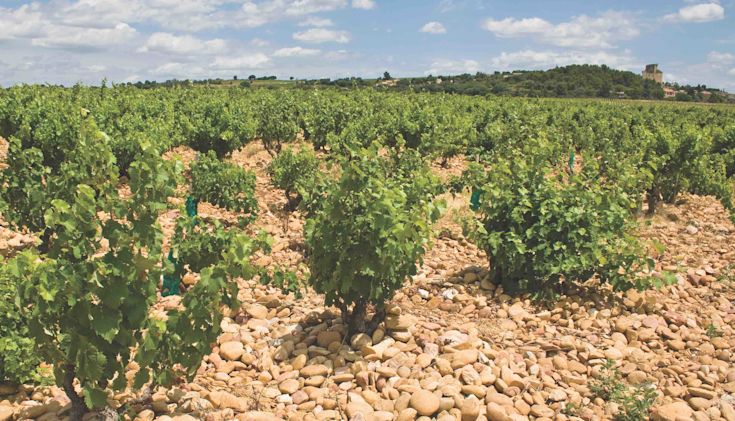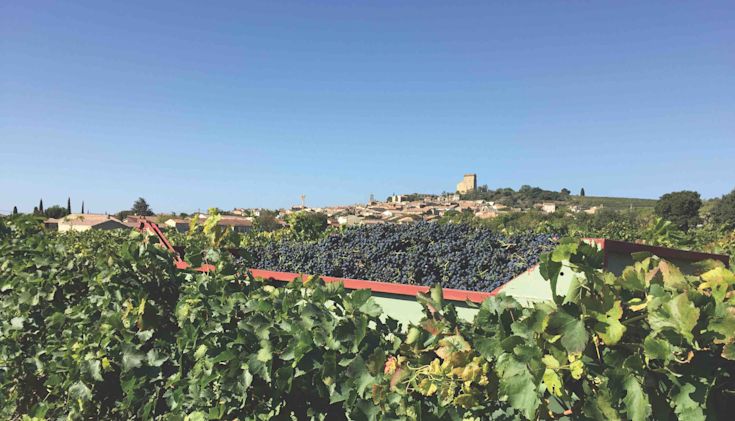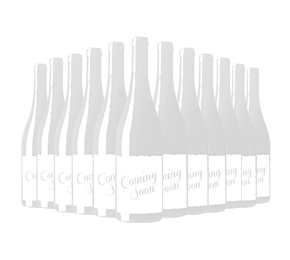Chat with Vinny
Châteauneuf-du-Pape is the home of some of France’s most premium blends – loved for their bold, sophisticated flavours. Learn what to serve Châteauneuf-du-Pape with, what makes it such a fine red, and everything in between.
If you asked a random selection of wine drinkers in the UK to name a fine red style, one of the most popular answers would almost certainly be Châteauneuf-du-Pape. It’s a name that’s instantly recognisable on a wine list, even among novice wine drinkers. And if you’re in the know, you can probably reel off a list of great producers.
Even the name just trips off the tongue. “I’ll have a bottle of the Châteauneuf-du-Pape please”. How many times has that simple request led to a truly memorable dining occasion?
So, why does Châteauneuf-du-Pape have such a fine reputation?
The most obvious answer is the quality of its wine. Châteauneuf-du-Pape is a hearty red wine that is very easy to enjoy, especially if you like reds with a little bit of power. And it has a herbal edge that speaks of the place from which it comes.
To underline the region’s dedication to quality, Châteauneuf-du-Pape was the driving force behind the development of the French appellation contrôlée (AOC) system. Spear-headed by local viticulturalist, Baron de Ley, the system was established to protect a wine’s provenance and to reward producers who adhered to higher quality standards. As a result, Châteauneuf-du-Pape became France’s (and the world’s) very first recognised appellation in 1936.

What type of wines does Châteauneuf-du-Pape produce?
More than 90% of wine produced in the appellation is red. It’s the standard bearer for wine that comes from the southern Rhône area. There is also small amount of white wine produced too. It’s a rich, round mouthfilling style that is at its best alongside food.
What does Châteauneuf-du-Pape taste like?
It’s a rich, robust red with a jammy texture and plenty of ripe fruit flavours on the nose and palate (think raspberries, plums, blackcurrant and violet). There are also herbal aromas reminiscent of the ‘garrigue’ scrubland that dominates the local landscape. This becomes more pronounced as the wine ages and develops leather notes and a savoury edge.
The wines also have an earthiness and spiciness. They have great texture too – luscious and lusty in their youth, becoming silkier and more refined with age. And you don’t have to wait an eternity before they’re ready to drink. You can enjoy them in their bloom of youth or lay down the best examples which will gain in complexity and depth. If you enjoy wines with plenty of fleshy fruit, but also with a degree of maturity and savoury richness, open up a top cuvée Châteauneuf-du-Pape any time between five and ten years of age. Sublime.
Vintages are generally consistently good as the region has a far more reliable, warmer and drier climate than other great French regions such as Bordeaux and Burgundy.
Châteauneuf-du-Pape wines have a tremendous quality to price ratio. ‘Very good’ in Châteauneuf costs way less than the same level in Bordeaux and Burgundy. And the wines come in an imposing bottle (often heavyweight – although this is likely to change as producers become more environmentally conscious – and deep punted) embossed with the Châteauneuf crest. It bears a striking resemblance to the Vatican City coat of arms and shows a papal triple-crown above the keys of Saint Peter with the words ‘Châteauneuf-du-Pape’.
The alcohol content is often high – typically between 13.5 and 15.5% – thanks to the area’s 2,800 hours of annual sunshine. There’s another reason for the wine’s power and ripeness. The vineyards are littered with large ‘pudding stones’ or ‘galets’ which heat up during the day and then radiate warmth up to the vines during the night. This produces grapes that are super juicy and extra concentrated.
However, don’t expect a wine that will overwhelm you with its fruit and structure. The key to a great Châteauneuf-du-Pape is a freshness and elegance that keeps all that fruit, and power in check. In short, it’s a wine that really does have it all.

What grapes is Châteauneuf-du-Pape made from?
The wines seldom include any reference to grape varieties on the label. But most of the wines are made from a combination of grapes, the most common of which are Grenache, Syrah and Mourvèdre. But there are actually 13 permitted varieties …
Grenache
Counoise
Mourvèdre
Muscardin
Syrah
Terret Noir
Vaccarèse
Bourboulenc
Clairette Blanche
Picardin
Winemakers are free to draw from this range, like an artist selects colours from a paint palette, to create distinctive wine styles.
Where is Châteauneuf-du-Pape?
The commune of Châteauneuf-du-Pape is in the Provence-Alpes-Côte d’Azur region, just to the north of the ancient town of Avignon. It’s in the southern Rhône, a wider, flatter and much more expansive area than the northern Rhône. The region acts as a gateway to Provence and the Mediterranean and Châteauneuf is right at its heart. The vineyards are located around Chateauneuf du Pape and in the neighbouring villages of Bedarrides, Courthézon and Sorgue between Avignon and Orange.
What is the history of Châteauneuf-du-Pape and its name?
The story behind the wine’s name goes back to the early 14th century when a volatile political climate in Rome caused the papacy to relocate to Avignon which at the time was in the Kingdom of Arles and part of the Holy Empire. Pope John XXII, the second of the popes to reside in Avignon, was so charmed by a nearby village that he established a grand summer residence known as the ‘Pope’s new castle’ … which in French is Châteauneuf-du-Pape.
However, an 11th century Latin document records the village’s name as Castro Novo, with Castro denoting a fortified village rather than a castle. Ruins of the papal castle still remain, standing at the top of the hill on which the village stands.
Although wine had been produced in the area long before the arrival of the papacy, the local wine attained the status of ‘Pope’s Wine’ during the 14th century. And that ascension led to it becoming red wine of choice at many of the great European courts.

By the mid 14th century, nearly half of the land in what we now call Châteauneuf-du-Pape was given over to grape growing. Most of the other French regions which are now renowned for vineyards were still dominated by cereal crops. But the vineyard holdings were small and scattered across a wide area. That’s probably why to this day, the major estates have vineyards across many different sites.
By the mid 17th century, it had developed a Europe-wide reputation for great red wine whose style was somewhere between that of the Languedoc and Bordeaux. That claret-style freshness is still a hallmark of the best wines from Châteauneuf-du-Pape.
In 1866, Châteauneuf recorded another first – albeit very much unwanted – when it became the first French wine region to be decimated by phylloxera. It took many decades for the area to bounce back – but it did so in spectacular fashion.
And what of the ‘Pope’s new castle’? This imposing hilltop construction dominated the landscape for centuries and survived much political upheaval. But much of it was destroyed by the German army as they retreated and set off munitions. Today, only the cellar and the south side of the keep remain. But still proudly standing guard over the village and the surrounding vineyards.
What is the climate, geography and terroir of Châteauneuf-du-Pape like?
If you’ve ever visited Châteauneuf-du-Pape or its near neighbour Avignon in summer, you’ll know how hot it gets. The climate is Mediterranean, which results in hot and dry summers and warm and moist winters. During the summer, the mistral wind sweeps through the region, intensifying the heat and dryness.
The appellation reaches 120m at its highest point. The vineyards are largely on flat land or gentle slopes at an average altitude of 70m.
The terroir consists of three distinct soil types. In the north and northeast of the appellation, those heat-retaining galet stones (quartzite remnants of Alpine glaciers made smooth over millennia by the Rhône river) sit on a layer of clay. Sandier soils dominate in the east of the appellation, becoming grittier in the south. But if you visit the vineyards, your abiding memory will be of those big pudding stones. Ever so smooth and hot to the touch long after the sun has set.
How much Châteauneuf-du-Pape wine is made?
Okay, are you ready for the number? You might be surprised. The appellation’s 3,200 hectares of vines produce around 14 million bottles each year. That’s more than the entire northern Rhône region (home to famous appellations such as Côte-Rôtie and Hermitage). However, to put this into an even more local context, the largely southern Rhône-based Côtes-du-Rhône appellation produces more than 400 million bottles in a typical vintage.
Despite what might look like a large production figure, small is still beautiful in Châteauneuf-du-Pape. There are still only 300-plus growers in Châteauneuf-du-Pape, of which around 250 produce and bottle their own wines. The majority of these are small, family-run producers, responsible for the 100 or so much sought-after Châteauneuf-du-Pape super cuvées.
What to serve with Châteauneuf-du-Pape wine?
Châteauneuf-du-Pape wines are bold, full-bodied and flavourful – and are best served with hearty meat dishes like braised lamb shanks, roast week, duck or barbecued ribs.
If you want to be really authentic, you could partner a Châteauneuf-du-Pape red with a classic French dish like beef bourguignon or navarin lamb.
Serving after dinner? Pair with bold cheeses such as aged mature Cheddar or Roquefort.

What Châteauneuf wines would you recommend?
The beauty of Châteauneuf-du-Pape is that you can enjoy truly classic bottles without having to spend a fortune. Laithwaites stock a range of hugely popular releases that offer superb quality and outstanding value. Here are our top picks …
Le Prince de Courthézon 2022
One of our bestselling Châteauneuf-du-Pape wines, this is made by multi-Gold-medal-winning winemaker Thierry Ferlay at the appeallation’s only co-operative cellar. All the grape growers are co-owners, so the focus is on quality from vineyard to bottle.
Cuvée du Vatican 2022
The Diffonty family launched this wine in 1958 with the blessing of the Pope. It’s extraordinarily rich and ripe and provides you with a wonderful introduction to rich, warming style that is family-made Châteauneuf-du-Pape.
Création d’Emilie B 2021
Emilie Boisson’s family has been involved in winemaking in Châteauneuf-du-Pape since the 17th century. This wine combines grapes from four different terroirs (Le Crau, Les Serres, Les Plagnes and Le Parc) and delivers richness, complexity and spiced red fruit in perfect harmony.
And now for the super cuvées, wines that take you to the very top tier of Châteauneuf quality …
Château de Beaucastel 2021
Owned by the Perrin family, this is one of the most highly regarded Châteauneuf-du-Pape estates of all. They use laser sorters to make sure only the ripest grapes are selected, resulting in smoky, concentrated style with incredible freshness and finesse.
Famille Isabelle Ferrando 2020
This tiny, relative newcomer has forged a huge reputation for its mesmerising, old-vine Châteauneuf. Only 550 cases are made a year – a vibrant, delicate and complex masterpiece of red fruit, herbs, flora and pepper.
Clos des Papes 2021
The Avril family have been making wines in Châteauneuf-du-Pape since the start of the 18th century and their Clos des Papes, founded in 1896, is a benchmark for the appellation. Great now, but this wine will age magnificently.
About the author
Steve Rumble
When Steve first started writing for Laithwaites, dry rosé wasn’t a thing in the UK, the only Malbec we stocked was French and hardly any Brits could pronounce Rioja. Things have changed but Steve still loves telling the great stories behind our wines. He holds the WSET Level 4 Diploma and loves a good Provence pink or an oaky Chardonnay. Steve has sports writing experience and is our go-to writer for all things Laithwaites and England Cricket.

